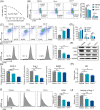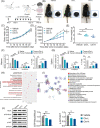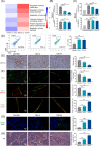Chrysin targets myeloid-derived suppressor cells and enhances tumour response to anti-PD-1 immunotherapy
- PMID: 36121176
- PMCID: PMC9484264
- DOI: 10.1002/ctm2.1019
Chrysin targets myeloid-derived suppressor cells and enhances tumour response to anti-PD-1 immunotherapy
Conflict of interest statement
The authors declare that they have no competing interests.
Figures




Similar articles
-
Targeting Inhibition of Accumulation and Function of Myeloid-Derived Suppressor Cells by Artemisinin via PI3K/AKT, mTOR, and MAPK Pathways Enhances Anti-PD-L1 Immunotherapy in Melanoma and Liver Tumors.J Immunol Res. 2022 Jun 22;2022:2253436. doi: 10.1155/2022/2253436. eCollection 2022. J Immunol Res. 2022. PMID: 35785030 Free PMC article.
-
Immunosuppressive Effects of Myeloid-Derived Suppressor Cells in Cancer and Immunotherapy.Cells. 2021 May 11;10(5):1170. doi: 10.3390/cells10051170. Cells. 2021. PMID: 34065010 Free PMC article. Review.
-
Prim-O-glucosylcimifugin enhances the antitumour effect of PD-1 inhibition by targeting myeloid-derived suppressor cells.J Immunother Cancer. 2019 Aug 28;7(1):231. doi: 10.1186/s40425-019-0676-z. J Immunother Cancer. 2019. PMID: 31462297 Free PMC article.
-
TIGIT/CD155 blockade enhances anti-PD-L1 therapy in head and neck squamous cell carcinoma by targeting myeloid-derived suppressor cells.Oral Oncol. 2021 Oct;121:105472. doi: 10.1016/j.oraloncology.2021.105472. Epub 2021 Jul 30. Oral Oncol. 2021. PMID: 34333450
-
Role of myeloid-derived suppressor cells in immune checkpoint inhibitor therapy in cancer.Arch Pharm Res. 2019 Jul;42(7):560-566. doi: 10.1007/s12272-019-01165-6. Epub 2019 May 30. Arch Pharm Res. 2019. PMID: 31147902 Review.
Cited by
-
Electrospun Nanofibers from Plant Natural Products: A New Approach Toward Efficient Wound Healing.Int J Nanomedicine. 2024 Dec 27;19:13973-13990. doi: 10.2147/IJN.S501970. eCollection 2024. Int J Nanomedicine. 2024. PMID: 39742091 Free PMC article. Review.
-
Flavonoids in the Treatment of Non-small Cell Lung Cancer via Immunomodulation: Progress to Date.Mol Diagn Ther. 2025 May;29(3):307-327. doi: 10.1007/s40291-025-00772-y. Epub 2025 Mar 4. Mol Diagn Ther. 2025. PMID: 40036006 Review.
-
Anti-Inflammatory Mechanisms of Dietary Flavones: Tapping into Nature to Control Chronic Inflammation in Obesity and Cancer.Int J Mol Sci. 2022 Dec 12;23(24):15753. doi: 10.3390/ijms232415753. Int J Mol Sci. 2022. PMID: 36555392 Free PMC article. Review.
-
Metabolic reprogramming and therapeutic resistance in primary and metastatic breast cancer.Mol Cancer. 2024 Nov 21;23(1):261. doi: 10.1186/s12943-024-02165-x. Mol Cancer. 2024. PMID: 39574178 Free PMC article. Review.
-
Advancements and recent explorations of anti-cancer activity of chrysin: from molecular targets to therapeutic perspective.Explor Target Antitumor Ther. 2024;5(3):477-494. doi: 10.37349/etat.2024.00230. Epub 2024 May 23. Explor Target Antitumor Ther. 2024. PMID: 38966181 Free PMC article. Review.
References
-
- Si Y, Merz SF, Jansen P, et al. Multidimensional imaging provides evidence for down‐regulation of T cell effector function by MDSC in human cancer tissue. Sci Immunol. 2019;4(40):eaaw9159. - PubMed
Publication types
MeSH terms
Substances
LinkOut - more resources
Full Text Sources
Medical
